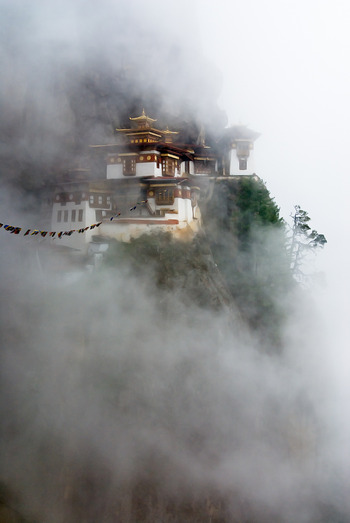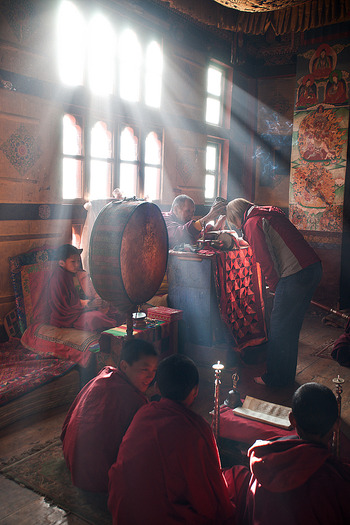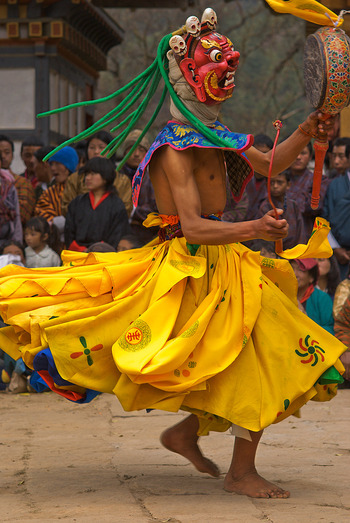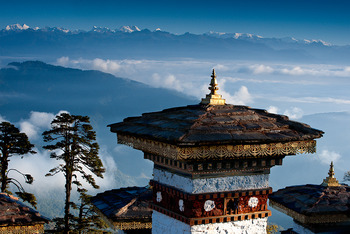Bhutan
This month’s featured photography comes from photographer Kim Walker of UniquePhotoTours.com
 Hidden high in the Himalayas, between northern India and Tibet, is Bhutan, a peaceful, idyllic country whose mantra is national happiness. Cliffside monasteries, medieval fortresses, lavish temples and Swiss Tudor farmhouses dot rural landscapes of terraced rice fields, mossy forests and snowy peaks. Isolated from the world by choice, Bhutan curbs modernization and mass tourism to protect its sacred heritage and preserve its culture. Only approved groups are permitted in this intriguing land where red-robed monks and villagers alike embrace ancient traditions, mythology, astrology and Buddism in their daily lives. The photo above is Taktsang, or Tiger’s Nest, one of the most sacred pilgrimage sites in the Himalayan World. The temple is perched on a granite cliff 2,000 feet above the valley floor. According to legend, Guru Rinpoche flew across the mountains on the back of a tigress to this ridge, meditated in a cave for three months, and converted the people of Paro Valley to Buddhism.
Hidden high in the Himalayas, between northern India and Tibet, is Bhutan, a peaceful, idyllic country whose mantra is national happiness. Cliffside monasteries, medieval fortresses, lavish temples and Swiss Tudor farmhouses dot rural landscapes of terraced rice fields, mossy forests and snowy peaks. Isolated from the world by choice, Bhutan curbs modernization and mass tourism to protect its sacred heritage and preserve its culture. Only approved groups are permitted in this intriguing land where red-robed monks and villagers alike embrace ancient traditions, mythology, astrology and Buddism in their daily lives. The photo above is Taktsang, or Tiger’s Nest, one of the most sacred pilgrimage sites in the Himalayan World. The temple is perched on a granite cliff 2,000 feet above the valley floor. According to legend, Guru Rinpoche flew across the mountains on the back of a tigress to this ridge, meditated in a cave for three months, and converted the people of Paro Valley to Buddhism.
 During our visit, we requested a private meeting with the Lama of Ura village. Recently paralyzed from an automobile accident, we met with him in his bedroom where he spoke to us about his Buddhist beliefs, physical challenges and faith. His father-in-law, a retired lama in his early 70s, performed a special blessing for each of us the next morning in the private temple. Sunlight streamed through the dusty windows as the lama and the young monks chanted from ancient texts, pounded a goat-skinned drum and blew deep resonating notes from a conch shell, thigh bone, and long metal horns. One by one we were motioned to advance the lama where he bestowed our blessing—a protection from misfortune.
During our visit, we requested a private meeting with the Lama of Ura village. Recently paralyzed from an automobile accident, we met with him in his bedroom where he spoke to us about his Buddhist beliefs, physical challenges and faith. His father-in-law, a retired lama in his early 70s, performed a special blessing for each of us the next morning in the private temple. Sunlight streamed through the dusty windows as the lama and the young monks chanted from ancient texts, pounded a goat-skinned drum and blew deep resonating notes from a conch shell, thigh bone, and long metal horns. One by one we were motioned to advance the lama where he bestowed our blessing—a protection from misfortune.
 Each district in Bhutan hosts an annual tshechu, or religious festival, to honor Guru Rinpoche. Locals dress up in their best gho or kira and bring picnic baskets for the all-day celebrations. Monks dress in vivid yellow skirts and colorful brochades, and perform long dances in the courtyard, jumping and swirling in front of the resident lama, other monks and the local villagers sitting on the ground around the courtyard. Each dance symbolizes something different—from morality plays to beliefs about life after death. Monks wear different masks to symbolize good and evil spirits, animals or wrathful deities.
Each district in Bhutan hosts an annual tshechu, or religious festival, to honor Guru Rinpoche. Locals dress up in their best gho or kira and bring picnic baskets for the all-day celebrations. Monks dress in vivid yellow skirts and colorful brochades, and perform long dances in the courtyard, jumping and swirling in front of the resident lama, other monks and the local villagers sitting on the ground around the courtyard. Each dance symbolizes something different—from morality plays to beliefs about life after death. Monks wear different masks to symbolize good and evil spirits, animals or wrathful deities.
 At Dochula Pass, at an altitude of 10,000 feet, you can see peaks of the Eastern Himalayas. But only on a clear day, and only during the months from October to February. In the foreground of this photo is one of the 108 chortens that were built to commemorate a military victory in 2003.
At Dochula Pass, at an altitude of 10,000 feet, you can see peaks of the Eastern Himalayas. But only on a clear day, and only during the months from October to February. In the foreground of this photo is one of the 108 chortens that were built to commemorate a military victory in 2003.
Kim Walker is a photographer, writer, speech-language pathologist, and tour operator who leads small group photography tours with her photographer husband to international destinations. To see more of her work, check out the galleries at www.UniquePhotoTours.com.